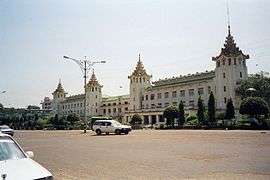Rail transport in Myanmar
Rail transport in Myanmar involves a 3,991 km (2,480 mi) railway network that is run by Myanmar Railways, a state-owned railway company under the Ministry of Rail Transportation.[1][2]
History
The first railway, in the then British colony of Lower Burma, opened in 1877 between Rangoon (Yangon) and Prome (Pyay), a distance of 163 miles (262 km). Unusually for a British colonial railway, it was built to metre gauge. Subsequent development was to the same gauge, and by the early 20th century a network of almost 2000 miles (3200 km) operated in Lower and Upper Burma. The Burma Mines Railway was a separate 2 ft (610 mm) gauge mining railway some 50 miles (80 km) in length in the Namtu area. Its first section opened in 1906.
The Japanese invasion during the Second World War caused considerable damage to the rail network. As part of their program of reconstruction they instituted the construction of the Thailand - Burma Railway using the labour of Allied prisoners of war, many of whom died in the attempt.
Further damage to the railways was caused as the Allies liberated the country from the Japanese. At the end of the war only about 1085 km of line remained operational, in four isolated sections. The costly “Death Railway” link with Thailand fell into disuse and the section of this line in Burma was permanently closed, but the remainder of the Burmese network was rebuilt over decades. In the 1970s further activity led to the construction of new lines, extending the network to around 4800km in extent.
In 2016 a tram route opened in Yangon, on a former heavy rail freight route through the city streets. Rolling stock is a three car train purchased second hand from Hiroshima, Japan; it is standard (1435 mm) gauge, and a third rail was added to the line to accommodate it.
Railway links to adjacent countries
Apart from the Thailand - Burma Railway the country has never had any international links. However:
- In 2010 and 2011, 1,435 mm (4 ft 8 1⁄2 in) standard gauge international lines north to China and east to Thailand from a new port and industrial area at Dawei were proposed.[3][4]
- Tentative plans exist to build a 1,920 km (1,190 mi) crossborder railway (with 1,435 mm or 4 ft 8 1⁄2 in standard gauge) from Yangôn to Kunming in China.[5]
- On April 9, 2010, the Government of India announced that it is considering a Manipur to Vietnam link via Myanmar, although this would require a break-of-gauge 1,435 mm (4 ft 8 1⁄2 in) (Burma)/1,676 mm (5 ft 6 in) (India).[6] India also proposed that these two proposed links be connected, allowing trains from Delhi to Kunming via Myanmar, but requiring break-of-gauge (1,435 mm or 4 ft 8 1⁄2 in (Burma)/1,676 mm or 5 ft 6 in (India).[7]
See also
References
- ↑ "Ministry of Rail Transportation". www.ministryofrailtransportation.com. Retrieved 2017-11-15.
- ↑ Brown, Pat (30 January 2008). "Railway Bazaar". The Irrawaddy.
- ↑ "Thai Developer Touts Burma Port Project - The Irrawaddy | Simon Roughneen". Simon Roughneen. 2011-06-08. Retrieved 2017-11-15.
- ↑ Murdoch, Lindsay (2011-10-01). "Burmese rebels block Asia's 'Suez Canal'". The Sydney Morning Herald. Retrieved 2017-11-15.
- ↑ "Railway Gazette: China's horizons extend southwards". 2011-01-06. Retrieved 2011-01-06.
- ↑ "Rail link from Manipur to Vietnam on cards: Tharoor". The Times Of India. 2010-04-09.
- ↑ "Railway eyes rail link to China". The Times Of India. 2011-03-10.
